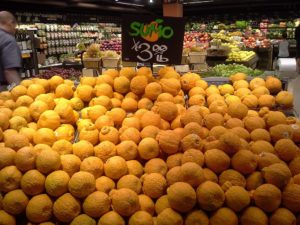
Year: The year ended March 2021
Market size: $62 million
When one thinks of citrus fruit, oranges, grapefruit, or lemons may come to mind. Today’s market size shows the total U.S. sales of one type of orange, the Sumo Citrus, for the year ended March 2021. Sumo Citrus sales accounted for nearly 3% of the $2.1 billion citrus fruit market that year. Since March 2018, sales have grown 35% per year.
Sumo Citrus, the brand name in the United States, is a fairly new variety of mandarin orange.1 This fruit was first introduced in Japan in the 1970s and by the 1990s had become a popular, beloved fruit there. It’s a hybrid of navel oranges, pomelos, and mandarin oranges. After the U.S. government banned the seedlings for many years for fear they would spread plant viruses, Suntreat (now AC Brands) was finally given permission to grow the fruit about 20 years ago. The fruit was first sold in the United States in 2011.Sumo Citrus’s popularity has grown since then, despite its high price. Sumo Citrus can cost 4 times as much as navel oranges. As a premium product that’s only in the season from January through April each year, the price may be seen as justified. In the United States, this fruit is only grown in the San Joaquin Valley in California. Sumo Citrus is difficult to grow. The skin is delicate, prone to sun damage. A clay-like substance is put over each fruit to protect it. Trees are hand-pruned. The fruit is hand-picked and hand-packed into each crate to make sure they don’t bruise. The trailers that transport the fruit to retailers are designed to provide a smooth ride to minimize damage in transit.
Why has this fruit become so popular? Perhaps it’s a combination of sweet taste, convenience (seedless, easily peeled), and marketing. While the short growing season can be seen as a disadvantage, AC Brands has turned it into a way to hype the fruit, encouraging consumers to buy the fruit while they can. Paid partnerships with social media influencers, ads in magazines, billboards in key markets, and prominent displays in supermarkets are other marketing strategies employed to influence consumers’ citrus buying habits.
1 The brand name was derived from the way the fruit looks. It’s a large fruit with a top knot, something like a sumo wrestler wears in the ring. In the United States, the brand name is synonymous with the name of the fruit itself.Sources: Danielle Wiener-Bronner, “This Little-known Japanese Fruit Now Has a Cult Following,” CNN Business, March 31, 2021 available online here; “FAQs,” Sumo Citrus available online here; “The Farms,” Sumo Citrus available online here.
Image source: Haruo, “File:Sumo (dekopon) supermarket display in Seattle.jpg,” Wikimedia Commons, February 25, 2016 available online here, CC BY-SA 4.0
